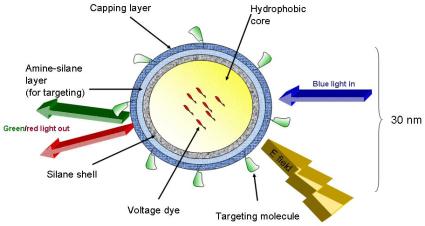Red Light ... Green Light ... 5 Millivolts
Ann Arbor (MI) - Researchers at the University of Michigan have developed a voltmeter so small and sensitive that it can measure 1000s of points of electrical voltage inside a cell. Using light emissions to determine voltage, instead of electrons, the 30 nm spheres receive a particular type of blue light and, based on the voltage present, reflect back red and green light. The ratio of red to green determines the voltage. And, according to the researchers, it is extremely accurate.
Dubbed a nano-optical voltmeter, or NOV, the scientists have already used this technology to simultaneously measure voltage at more than 1,000 separate points within a cell. The measurements they've taken have already revealed surprisingly high electric fields in the jellylike liquid material that makes up most of the cell - called cytosol. The data they've collected is accurate enough to build a working 3D model of the electrical activity in a cell. Scientists believe this may help determine why cancer cells grow so rapidly and how damaged nerve cells might be mended, among other things.
Professor Raoul Kopelman, who is the Richard Smalley Distinguished University Professor of Chemistry, Physics and Applied Physics at UofM, said, "The basic idea behind this field of research is to follow cellular processes, both normal and abnormal, by monitoring physical properties inside the cell. There's a long history of research on the chemistry happening inside the cell, but now we're getting interested in measuring the physical properties, because physical and chemical processes are related."
Kopelman believes there are many research efforts to be kicked off now that real scientific measurements have thwarted the previously held belief that cytosol, for example, was electrically neutral. He reports that meter per meter, the cytosol is 50% more electrically active than the average home. Changes in the electrical fields of cellular membranes are already known to play a role in diseases like Alzheimer's. Kopelman said, "I suspect that finding out exactly what's going on [inside the cell with all this electrical activity] will keep a lot of people working for a long time."
Research for this project was funded by Defense Advanced Research Project Agency (DARPA) BioMagnetics, the National Institutes of Health and the National Science Foundation's Division of Materials Research. Professor Kopelman discussed the nanoscopic voltmeters last Saturday during a special session of the American Society for Cell Biology in Washington, D.C., in a presentation entitled "Creating Next Generation Nano Tools for Cell Biology."
Author's opinion
When I toured Intel's debug laboratory recently where they work on future microprocessors, finding bugs, fixing problems, increasing clock speeds, etc., they showed me a device called a laser voltage probe (LVP). It was explained to me that when electrons move around, they emit photons as they change states. Based on the number of photons, their wavelength, and other observable factors over time, the LVP was able to determine the exact voltage, even through 100s of nm of silicon substrate. They could literally read the voltage on a bitline, the state of a transistor, watch it switch, etc., right through the silicon. This was possible because certain wavelengths of infrared light are transparent to silicon.
This new technology at UofM seems to have taken that science to a whole new level. By essentially backing up a figurative dump truck, and letting fly dozens, hundreds, even thousands of these tiny voltmeters into a cell, or really any area of interest, voltages at all points can be read simultaneously, and in real-time. This new abilities will allow scientists to observe the real changes which take place inside a cell during normal operations. A true map of what's really taking place can begin to be formed.
Get Tom's Hardware's best news and in-depth reviews, straight to your inbox.
It is just amazing what our science is able to do these days. And it's computers that make all of it possible, in one way or another. Imagine what man could do with computers that are 100s or 1000s of times faster than those we have today. We should have those, once the computers of this generation help man figure out how to make the computers of that generation.
